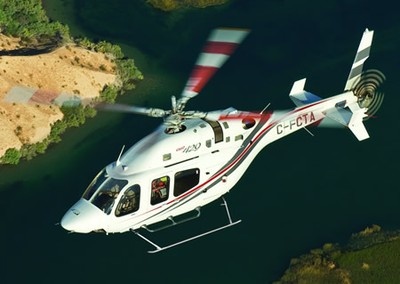Mon, Jan 16, 2012
Company Will Make Similar Case To The FAA, EASA
Transport Canada has approved a 500 lbs. weight increase for the
Bell 429 ... increasing the aircraft's maximum gross weight to
7,500 lbs. “This enhancement was the result of continued
requests from our customers to yield additional performance from
the Bell 429. Our customers told us they loved all the features and
performance the Bell 429 brings to bear but they wanted more range
to take better advantage of the helicopter’s IFR/WAAS
capabilities allowing for a greater safety margin by ensuring the
capacity for necessary fuel reserves for the growing number of
operations in the IFR environment,” said Larry Roberts,
senior vice president for Bell Helicopter’s Commercial
Business.
File Photo

“Outside of the previous certification limit at 7,000 lbs,
all the test data indicated that the Bell 429 would suffer no
technical constraints by increasing the gross weight to 7,500 lbs.
We reached out to the Bell 429’s certification authority,
Transport Canada, and have been working with them for several
months to validate what our data showed. After careful testing,
review and evaluation Transport Canada issued the exemption
approval for the gross weight increase,” Roberts said.
The Bell 429 is certified for Single or Dual Pilot IFR, Cat. A /
JAROPS Performance Class 1 at maximum gross weight; has a
state-of-the-art, fully-integrated glass cockpit; an advanced drive
system that delivers power and superb performance; best in class
WAAS navigation & IFR capability; and is the first helicopter
certified through the MSG-3 process. The additional gross weight
now permits operators to equip the Bell 429 with additional options
including Helicopter Terrain Awareness Warning System (HTAWS), a
radar altimeter, cockpit voice/flight data recorder and strobe
lights.
The increased gross weight directly translates to greater range
and loiter times. With Transport Canada’s approval now in
hand, Bell Helicopter will formally petition the FAA and EASA for
concurrence with Transport Canada on a 500 lbs. exemption to Part
27 with respect to the 7,000 lbs. maximum gross weight limit. We
have deep respect and a very good relationship with both the FAA
and EASA. We believe they will support Transport Canada’s
decision; after all, the exemption would allow for product
improvements that increase operational capability for owners and
operators making it a win/win for everyone,” Roberts
said.
The weight deviation improvement will have the capability to be
retrofitted to the existing fleet through the installation of a
minimal kit that will be available through Bell Helicopter.
Additionally, Bell Helicopter will issue the necessary changes to
the flight manual to correspond with the additional weight
capacity. All of this information will be made available through
Bell Helicopter and its customer support network throughout the
world.
More News
He Attempted To Restart The Engine Three Times. On The Third Restart Attempt, He Noticed That Flames Were Coming Out From The Right Wing Near The Fuel Cap Analysis: The pilot repor>[...]
Make Sure You NEVER Miss A New Story From Aero-News Network Do you ever feel like you never see posts from a certain person or page on Facebook or Instagram? Here’s how you c>[...]
From 2009 (YouTube Edition): Leading Air Show Performers Give Their Best Advice for Newcomers On December 6th through December 9th, the Paris Las Vegas Hotel hosted over 1,500 air >[...]
Aero Linx: NASA ASRS ASRS captures confidential reports, analyzes the resulting aviation safety data, and disseminates vital information to the aviation community. The ASRS is an i>[...]
“For our inaugural Pylon Racing Seminar in Roswell, we were thrilled to certify 60 pilots across our six closed-course pylon race classes. Not only did this year’s PRS >[...]
 NTSB Final Report: Rutan Long-EZ
NTSB Final Report: Rutan Long-EZ ANN FAQ: Turn On Post Notifications
ANN FAQ: Turn On Post Notifications Classic Aero-TV: ICAS Perspectives - Advice for New Air Show Performers
Classic Aero-TV: ICAS Perspectives - Advice for New Air Show Performers ANN's Daily Aero-Linx (06.28.25)
ANN's Daily Aero-Linx (06.28.25) Aero-News: Quote of the Day (06.28.25)
Aero-News: Quote of the Day (06.28.25)



